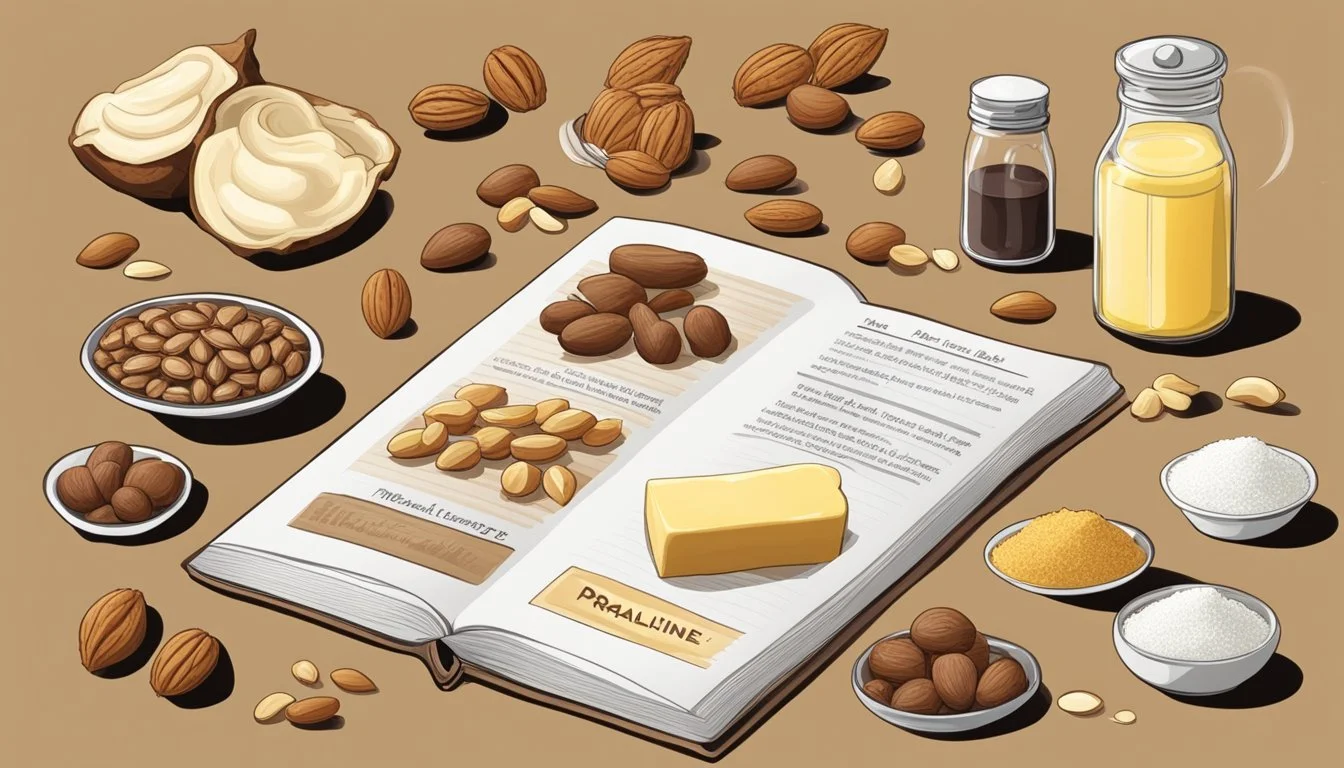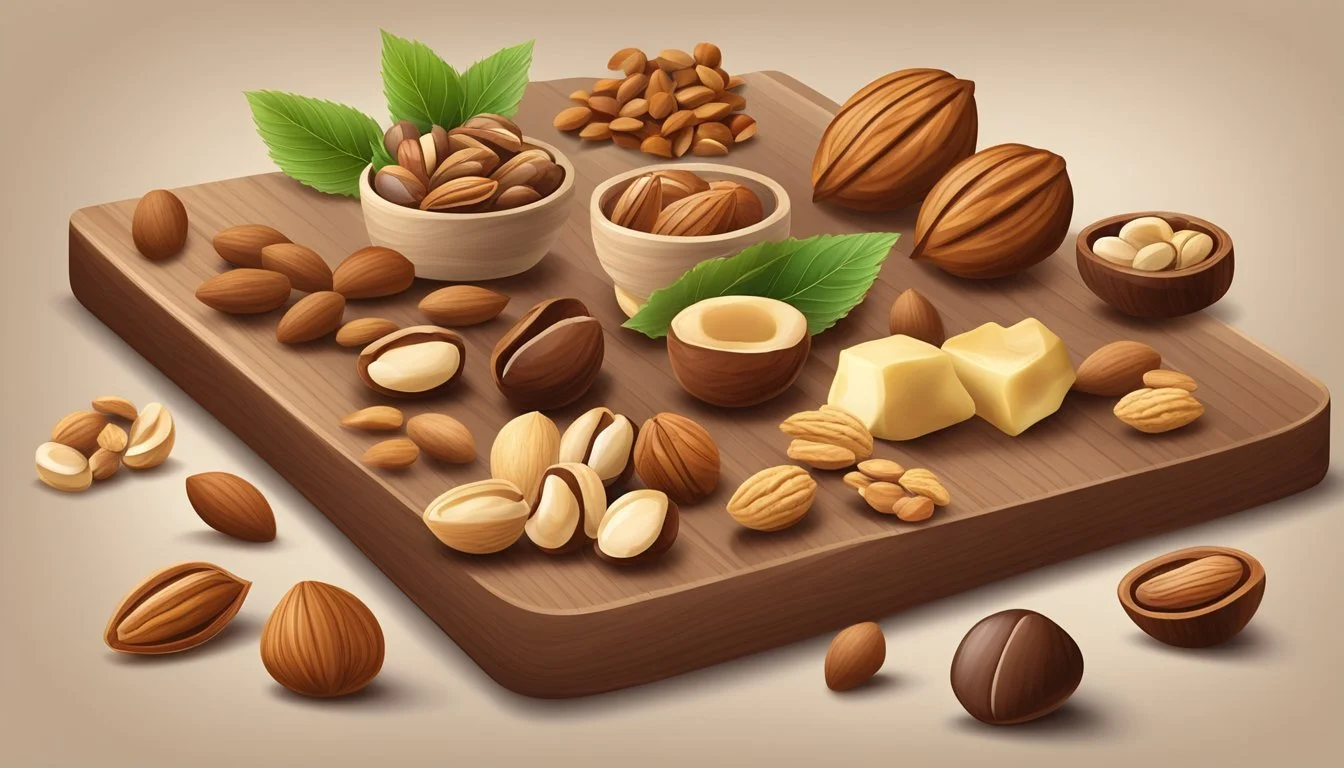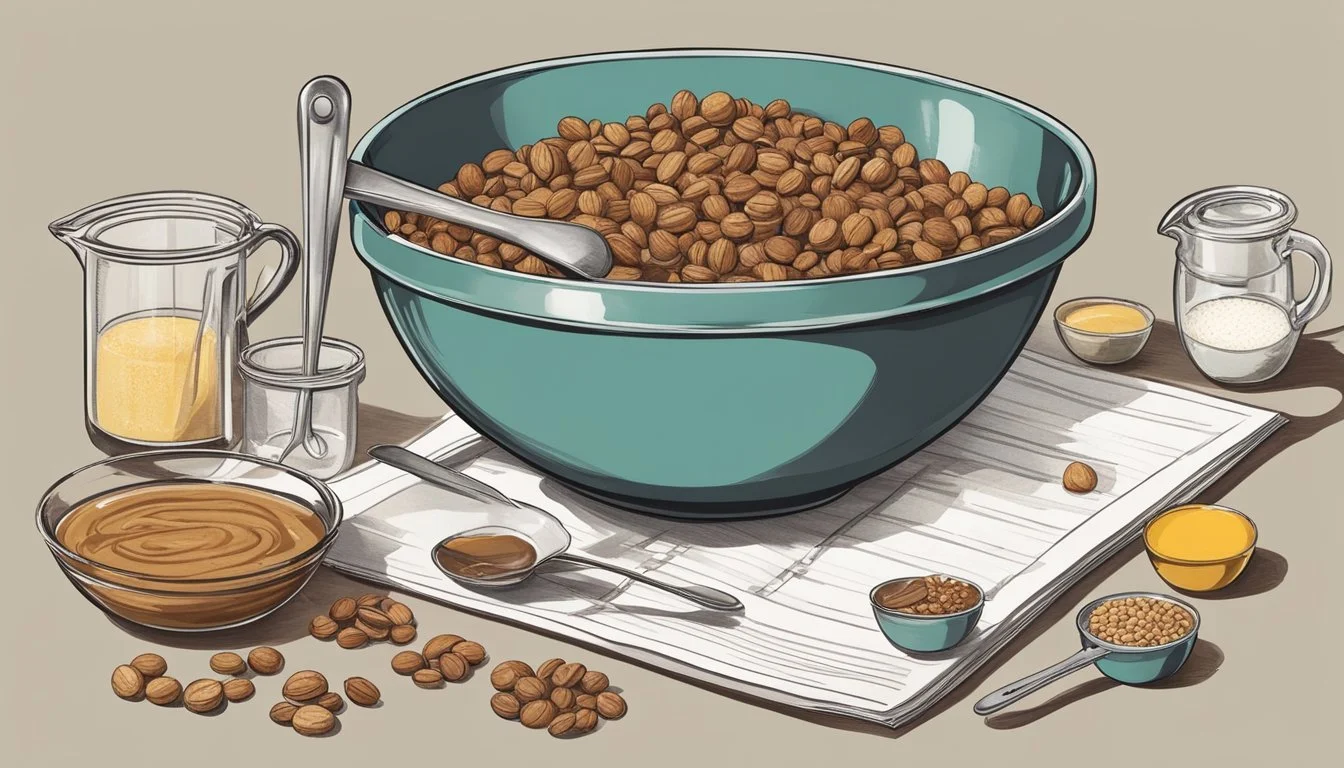Praline Substitutes
Best Alternatives for Your Recipes
Finding the perfect praline liqueur substitute can elevate your culinary creations without a hitch. One of the closest alternatives to Praline liqueur is Frangelico, a popular liqueur made from hazelnuts and herbs, boasting cocoa, vanilla, and coffee flavors. Its rich, toasty nuttiness naturally complements a wide variety of recipes.
For those seeking non-alcoholic options or maintaining a keto lifestyle, there are great choices available. Keto-friendly pralines or pecan pralines are creamy, buttery, and nutty, offering a melt-in-your-mouth experience without the sugar rush. These alternatives ensure you can enjoy the classic praline taste in a health-conscious manner.
Beyond these, praline paste made with hazelnuts or almonds offers a flexible substitute suitable for spreads, fillings, or flavoring desserts. This versatile option ensures that no matter your dietary restrictions or preferences, you have a suitable praline substitute ready to enhance your dishes.
Understanding Pralines
Pralines are a widely cherished dessert with deep roots, particularly in the culinary traditions of New Orleans.
Traditional pralines are made with a mixture of sugar, cream, and pecans. The sweetness of the sugar is balanced by the richness of the cream and the crunchy texture of the pecans.
In New Orleans, pralines became popular in the 19th century. Street vendors would sell these sweets, cementing them as a staple of local cuisine.
The flavor of pralines is often described as both nutty and buttery, enhanced by the caramelization of sugar. The texture is typically crunchy yet melts in the mouth, providing a satisfying contrast.
Making pralines usually involves cooking sugar and cream until they reach a specific consistency, then adding the pecans before the mixture cools.
Different types of pralines exist. For example, French pralines often use caramelized nuts while American pralines tend to be softer, integrating cream or butter.
Here is a common recipe breakdown for traditional New Orleans pralines:
Ingredients:
2 cups sugar
1 cup heavy cream
2 cups pecan halves
Instructions:
Heat the sugar and cream until bubbling.
Stir in the pecans.
Pour onto a baking sheet to cool.
By keeping these details in mind, one can grasp why pralines have remained a beloved sweet treat for generations.
Praline Substitutes Overview
When looking for praline substitutes, there are several options that can mimic its distinct nutty flavor and texture. Substitutes can be chosen based on dietary needs, ingredient availability, or personal preference.
Frangelico is a popular substitute. Made from hazelnuts, it provides a rich, nutty flavor similar to praline. It also features cocoa, vanilla, and coffee, making it versatile in various recipes.
For those avoiding alcohol or looking for a healthier option, consider hazelnut extract. Add 1 1/2 teaspoons for a potent praline flavor. This substitute is lower in calories and suitable for low-carb and keto diets.
A homemade hazelnut praline paste can also be an effective substitute. Simply toast hazelnuts, remove the skins, and grind them into a paste. This paste is rich in protein and fiber, adding nutritional value to recipes.
Marzipan offers a different but similar sweetness and texture. Made from almonds, it may not replicate the exact flavor of praline but can be an effective alternative in many desserts.
For those focusing on nutrition, a sugar substitute combined with nut extracts can work well. Sugar substitutes like stevia or erythritol paired with almond or hazelnut extract can mimic the sweetness and nuttiness of praline while being lower in calories and carbs.
Using a variety of substitutes allows flexibility in adjusting recipes to fit specific dietary requirements or ingredient availability, ensuring that the delightful nutty flavor of praline can still be enjoyed.
Nut-Based Substitutes
Nut-based praline substitutes are diverse, offering distinct flavors and textures. This section highlights almond, walnut, and hazelnut praline options, discussing their unique properties and best uses.
Almond Praline
Almond praline is a popular choice due to its nutty flavor and versatile use. Almonds offer a slightly sweet and crunchy texture, making them ideal for both sweet and savory dishes.
To create almond praline, roast the almonds to enhance their flavor. After roasting, caramelize sugar in a pan, then add the roasted almonds, stirring continuously until well coated.
Almond praline can be used in desserts like cakes and pastries, as well as a topping for ice creams and other treats. The crunch and nutty undertones add a depth of flavor that can complement a variety of ingredients.
Walnut Praline
Walnut praline pairs a slightly bitter yet nutty flavor with a crunchy texture. Walnuts are generally cost-effective and can be used in both desserts and savory dishes, providing versatility.
To make walnut praline, roast the walnuts first to bring out their natural oils. Caramelize sugar in a pan, then introduce the walnuts and stir until they are all well coated.
Incorporating walnut praline into recipes like cookies, tarts, and even salads can enhance the dish with its rich flavor. For those who enjoy a touch of sophistication, adding a splash of walnut liqueur like Nocello can elevate the praline's taste.
Hazelnut Praline
Hazelnut praline is a classic choice, known for its potent nutty flavor and unmistakable crunch. Hazelnuts are slightly sweet and pair well with chocolate, making them excellent for various confectioneries.
To prepare hazelnut praline, first, roast the hazelnuts to loosen their skins and deepen their flavor. Caramelize sugar in a pan, then add the roasted hazelnuts, stirring until they are well-enveloped in sugar.
Use hazelnut praline in spreads, fillings, or as a topping for pastries. A hint of hazelnut liqueur can further intensify the richness and depth of the praline, enhancing the flavor profile of your culinary creations.
Seed and Legume-Based Substitutes
Seed and legume-based alternatives to praline offer nutritious and tasty options, focusing on health benefits and protein content. These substitutes use common ingredients like sunflower seeds and soy nuts to replicate the flavors and textures of traditional praline.
Sunflower Seed Praline
Sunflower seeds make a delicious and nutritious alternative to traditional praline. They are rich in protein, providing approximately 5.5 grams per ounce, and they also offer healthy fats and vitamins.
To prepare sunflower seed praline, roasted sunflower seeds are combined with a caramelized sugar mixture. This blend ensures a similar crunchy texture and sweet flavor to classic praline.
Ingredients:
Sunflower seeds: roasted to enhance flavor
Caramel: made from sugar and water
Sunflower seed praline boasts several health benefits. It is a great source of Vitamin E, which supports skin health and acts as an antioxidant. Moreover, sunflower seeds contain magnesium, beneficial for muscle function and bone health. They are a more allergy-friendly nut substitute, suitable for those with nut allergies.
Soy Nut Praline
Soy nuts, which are roasted soybeans, present another excellent praline substitute. They are packed with protein, containing about 11 grams per ounce, making them a valuable addition for those seeking high-protein snacks.
Preparing soy nut praline involves coating soy nuts in a caramel or sugar mixture. This preparation method retains the desired crunch and sweetness characteristic of praline.
Ingredients:
Soy nuts: roasted for enhanced flavor
Caramel or sugar coating: to mimic the praline texture
Soy nut praline is beneficial for health due to its high protein content, essential for muscle repair and growth. Additionally, soy nuts are rich in fiber, which aids digestion, and they contain isoflavones, compounds that may contribute to heart health. This alternative is perfect for those looking to increase their plant-based protein intake without sacrificing taste.
Low-Carb and Sugar-Free Alternatives
These alternatives offer delicious flavors without compromising your dietary goals. They employ different low-carb sweeteners and ingredients that provide a sweet taste while being keto-friendly.
Keto-Friendly Pecan Pralines
Keto-friendly pecan pralines are an excellent choice for those seeking a sugar-free option.
To make them, start by toasting pecans in the oven, which helps to enhance their flavor. In a pan, melt butter and add a low-carb sweetener like Swerve along with heavy cream.
Allow the mixture to achieve a caramel-like consistency before incorporating the toasted pecans. This combination ensures that the pralines are both sweet and crunchy without spiking blood sugar levels.
Maple Syrup Praline
Maple syrup pralines can also be made low-carb by using sugar-free maple syrup as the primary sweetener.
Choose a syrup that uses a lower glycemic index sweetener, such as monk fruit extract, to maintain sweetness without the high sugar content. Melt butter in a saucepan and mix it with the sugar-free syrup and a pinch of salt.
Once the mixture has thickened, add pecans and transfer the mixture into muffin cups for cooling. These pralines offer the unique, rich flavor of maple syrup while remaining keto-friendly.
Sugar-Free Syrup Praline
Sugar-free syrup pralines are a versatile option and can be made using various sugar-free syrups available on the market.
In a medium heat pan, combine butter and a sugar-free syrup of your choice. Stir in heavy cream to add richness and achieve the desired consistency. Next, add in your pecans and continue to stir until well-coated.
Set the pralines on a baking sheet to cool and harden. This method ensures that the pralines are flavorful and fit seamlessly into a low-carb diet.
Substitutes in Baking
In baking, finding the right substitute can save a recipe when key ingredients are missing. Butter can be replaced with coconut oil, margarine, or lard. For those who prefer a dairy-free option, 1 cup of vegetable shortening also works well.
When a recipe calls for buttermilk, mix 1 cup of milk with 1 tablespoon of vinegar or lemon juice. This creates an effective substitute in cakes and cookies, maintaining the desired tenderness and flavor.
Eggs are often essential for binding in recipes. Replace 1 egg with ¼ cup of mashed banana, pumpkin, or applesauce. Another method is to use 1 tablespoon of flax seeds mixed with 3 tablespoons of water. These options work well in desserts like pecan cookies or chocolate cakes.
Replace cake flour by adding 2 tablespoons of cornstarch to a 1-cup measuring cup, then filling the rest with all-purpose flour. This substitution is useful when making light and fluffy cakes.
For those who run out of vanilla extract, use equal parts of almond extract or maple syrup to keep that fragrant sweetness in your baked goods.
Lastly, 1 cup of vegetable oil can be swapped with 1 cup of applesauce in recipes to lower the fat content without compromising moisture, making it a perfect fit for baking healthier desserts.
Each substitute ensures that the final product retains its desired texture and flavor, making these handy alternatives essential for any baker.
Non-Nut Substitutes and Additions
For those who need non-nut alternatives in their praline recipes, there are several excellent options. Crisp rice cereal is a popular choice. It offers the crunch similar to nuts. Start with half the amount called for and adjust to taste.
Pumpkin and sunflower seeds can also be used. These seeds offer a similar texture and can be roasted for added flavor. Squash seeds fall into this category as well.
Pretzels provide a salty, crunchy addition to pralines. They can be broken into small pieces and mixed with caramel or chocolate to create delightful treats. This substitution works well for those who enjoy a sweet-salty combination.
Extracts such as vanilla or almond extract can be incorporated for additional flavor without using nuts. Adding a few drops to the mixture can enhance the overall taste profile.
Chocolate chips or chunks can be a delicious addition to praline recipes. They add a rich, sweet flavor, making the pralines even more indulgent. Dark, milk, or white chocolate varieties can be used based on preference.
In the pantry, granola can serve as another substitute. Granola often contains a mix of oats and seeds, providing a crunchy texture that works well in pralines.
For a more unique twist, consider adding a coffee or chocolate liqueur to the praline mixture. This can add a depth of flavor, making the treat suitable for more grown-up tastes.
Ice cream toppings such as toffee bits or butterscotch chips can also be incorporated into pralines. These toppings are readily available and add a delightful crunch and sweetness.
By using these non-nut substitutes and additions, you can create a variety of delicious praline treats that cater to different dietary needs and preferences.
Substitutes in Beverages and Cocktails
When it comes to finding alternatives to praline liqueur in beverages and cocktails, there are some excellent choices that can replicate the nutty, sweet flavors. These substitutions can enhance the taste and complexity of your drinks while maintaining a delightful balance.
Praline Liqueur Alternatives
Frangelico is a fantastic substitute for praline liqueur due to its similar nutty profile. Made from hazelnuts, this Italian liqueur offers a rich and sweet taste. It's perfect for cocktails like the Nutty Martini or combined with coffee for a warm and flavorful drink.
Amaretto is another great option with its almond flavor and slightly higher alcohol content. This liqueur can be used in classic cocktails such as the Amaretto Sour or mixed with cream for a smooth, dessert-like beverage. Its sweetness and nutty undertone make it a versatile choice.
Walnut Liqueur provides a bold nutty flavor with hints of spice and sweetness, similar to praline liqueur. Toasted and macerated walnuts create a deep, earthy taste that works well in cocktails like the Walnut Old Fashioned or in creative, nut-flavored liqueur blends.
These alternatives—while different in their specific nut base—offer wonderful replacements for praline liqueur in various beverages and cocktails, adding unique and rich flavors to any drink recipe.
Storing Praline Substitutes
When storing praline substitutes, it is crucial to maintain their freshness and shelf life.
Airtight containers play a vital role in ensuring that the substitutes stay fresh. These containers prevent moisture from entering, which can cause the pralines to become sticky or spoil.
It's best to store praline substitutes in the pantry. This location typically offers a cool, dry environment, which is ideal for these confections. Avoid storing them in areas with high humidity.
Temperature is another factor to consider. Praline substitutes should be kept at room temperature, ideally between 60-70°F (15-21°C). Extreme temperatures can negatively impact their texture and taste.
If the praline substitutes are made from ingredients like nuts or sugar, it's important to check their individual storage requirements. Nuts, for example, can turn rancid if exposed to heat.
To prevent the praline substitutes from sticking together, line the bottom of the storage container with parchment paper. This also helps in easy removal without breaking.
Ensure that the container is placed away from direct sunlight and heat sources. This helps in maintaining the quality and shelf life of the praline substitutes.
By following these simple steps, praline substitutes can retain their freshness for a longer time, offering a delightful flavor whenever needed.
Dietary Considerations
When substituting pralines, dietary considerations play a crucial role in choosing the right alternative.
Calories: Traditional pralines are high in calories due to sugar and butter. Substitutes like sugar-free options or those made with non-fat Greek yogurt can significantly reduce caloric intake.
Keto-Friendly: For those on a keto diet, blood sugar levels need careful management. Keto pralines made with sweeteners like erythritol or stevia offer a low-carb alternative.
Allergies: Nut allergies are a common dietary concern. When substituting pralines, one can use sunflower seeds or pumpkin seeds to avoid allergens while preserving a similar texture.
Health: Choosing substitutes with high nutrient profiles can improve overall health. Alternatives like pecans in pralines provide essential minerals like manganese, copper, and zinc. Adding fiber-rich ingredients like chia seeds can also be beneficial.
Low-Carb: Substituting high-sugar ingredients with ones like monk fruit sweetener helps maintain a low-carb diet while enjoying the texture and sweetness of pralines.
Substitute Option Benefits Non-fat Greek Yogurt Low in calories, high in protein Erythritol/Stevia Keto-friendly, low-carb sweetening options Sunflower Seeds Nut allergens-free, rich in healthy fats Pecans High in vitamins and minerals, help meet micronutrient needs
When considering dietary needs, it is important to choose praline substitutes that cater to individual health requirements without compromising taste.
Special Occasions and Seasonal Uses
Praline substitutes can shine during special times of the year. Holidays, particularly Thanksgiving and Christmas, are perfect for using alternatives to traditional pralines.
Thanksgiving:
Pecan pie often takes center stage. Substituting praline pecans with candied nuts or caramelized nuts can offer a delightful variation while maintaining the crunch and sweetness.
Christmas:
For Christmas desserts, consider incorporating praline substitutes like toffee bits or crushed caramel candies. These can be used in cookies, cakes, and even sprinkled over ice cream for a festive touch.
Easter:
Easter celebrations often feature a variety of sweets. Adding praline substitutes to carrot cake or using them as a topping for cheesecake adds a rich, nutty flavor.
Here is a simple comparison of praline substitutes suitable for holiday desserts:
Occasion Praline Substitute Dessert Example Thanksgiving Candied Nuts Pecan Pie Christmas Toffee Bits Christmas Cookies Easter Crushed Caramel Candies Cheesecake Toppings
Using these substitutes ensures that the essence of pralines is captured, while catering to different preferences or dietary needs.
Culinary Creative Uses
Praline substitutes bring a unique twist to various culinary applications. With their rich flavor and crunchy texture, they can elevate both sweet and savory dishes.
In salads, praline substitutes like candied nuts or seeds add a delightful crunch. They complement fresh greens and can be paired with vinaigrette to enhance the overall taste experience.
For snacks, praline substitutes offer a satisfying sweetness and crunch. These can be enjoyed on their own or mixed into granola for an extra layer of flavor.
Cooking with praline substitutes opens up numerous possibilities. They can be crushed and used as a flavorful coating for meats, providing both texture and taste. Try using them in a breadcrumb mix for a unique twist on traditional recipes.
When it comes to baking, praline substitutes can be incorporated into batters and doughs. Mix them into cookies, muffins, or cakes for added richness and crunch. Alternatively, sprinkle them over desserts like ice cream or yogurt.
Flavor is key, and praline substitutes can vary from sweet to slightly savory depending on the ingredients used. This versatility makes them suitable for various culinary creations.
For a crunchy texture in your dishes, consider praline substitutes like toasted nuts or seeds. They not only provide texture but also balance out flavors, making dishes more enjoyable.
Incorporate these substitutes creatively, and they will surely enhance your culinary creations with their distinct taste and texture.













